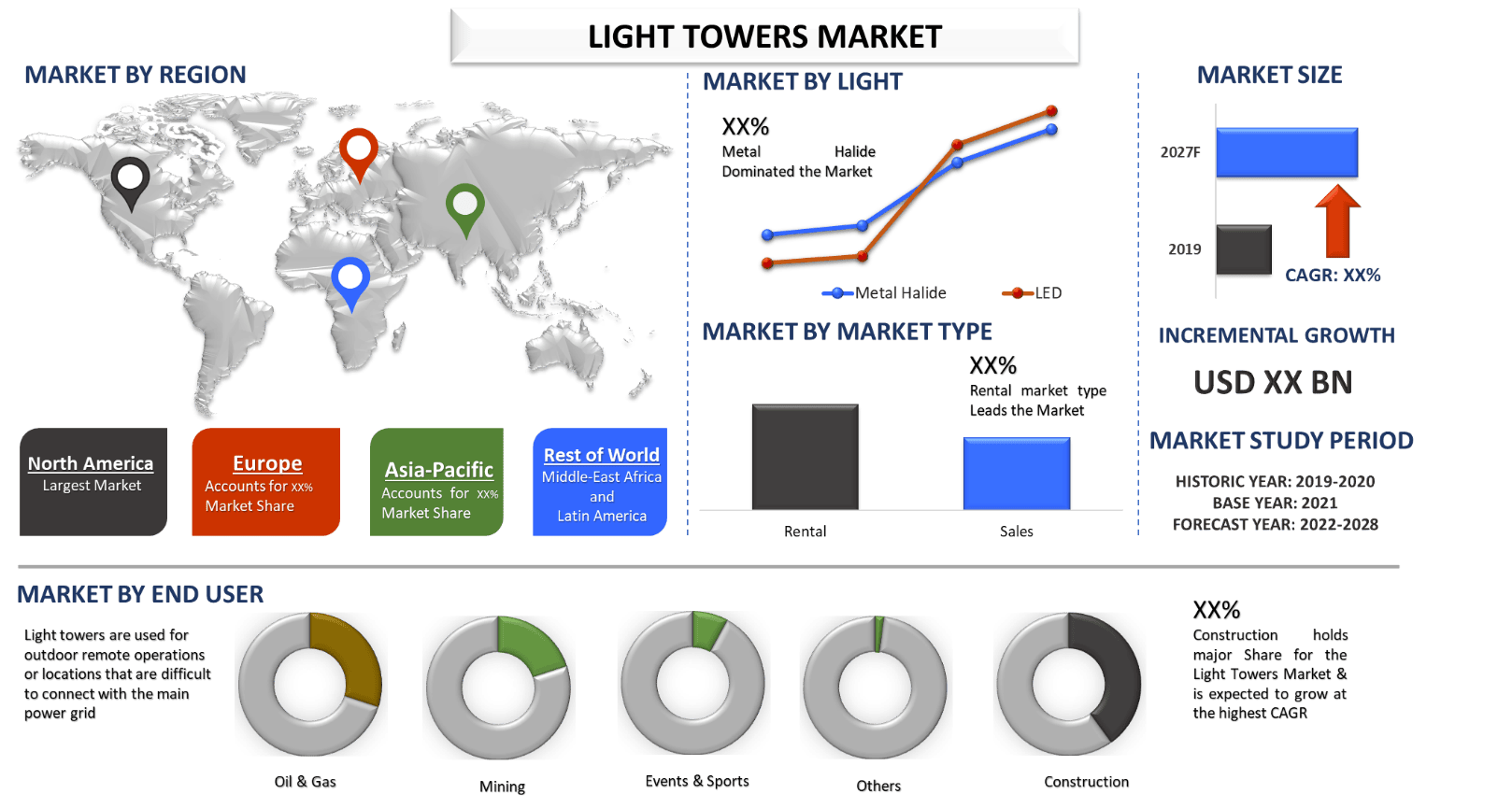- Home
- About Us
- Industry
- Services
- Reading
- Contact Us
Light Towers Market: Current Analysis and Forecast (2021-2027)
Emphasis on Market Type (Sales, Rental); Light Type (LED, Metal Halide); Fuel Type (Diesel, Solar/Hybrid, Direct Power, Others); End User (Oil & Gas, Mining, Construction, Events & Sports, Others); Region and Country

Light Towers Market was valued at ~US$ 4 billion in 2020 and is expected to grow at a CAGR of ~6% over the forecast period (2021-2027). Light towers are towable, mobile equipment equipped with one or more high power electric lamps with telescopic mast assembly. The mast may be fixed or adjustable in its operations, which is attached to a trailer consisting of a generator set to power the light panels. Light towers are used for outdoor remote operations or locations that are difficult to connect with the main power grid. These operations involve construction activity (remote as well as general), oil & gas industry operations, mining operation, and emergency and rescue operation. Being mobile and portable, light towers can be moved easily from one location to another in an onsite operation. Apart from these industrial applications, light towers can also be used to illuminate highly remote and distant villages. The growth of Light Towers Market expanded significantly over recent years, underpinned by increasing investment in the construction and oil & gas sectors, innovative technology adoption for energy-efficient lightings, and their proven reliability, efficiency, and easy installation techniques for many end user activities. For instance, as per IEA, longer-term drivers of growth will continue to push up oil demand. As a result, by 2026, global oil consumption is projected to reach 104.1 mb/d. This would represent an increase of 4.4 mb/d from 2019 levels.
Other factor driving the growth of the Light Towers Market globally is rising emphasis on the reduction of energy bill along with energy-saving potential through digitalization which is set to complement the light tower installation globally.
Generac Power Systems, Terex Corporation, Atlas Copco, Doosan Portable Power, Wacker Neuson etc. are some of the prominent players operating in the Global Light Towers Market. Several M&As along with partnerships have been undertaken by these players to facilitate countries with more innovative Light Towers applications.
Insights Presented in the Report
“Amongst market type, Rental segment holds the major share.”
Based on market type, the market is segmented into Sales and Rental. The Rental segment grabbed XX% market share of the Global Light Towers Market and gathered revenue of USD XX billion in 2020. The segment is expected to grow at a CAGR of XX% during the forecast period to reach a market valuation of USD XX billion by 2027 driven by the demand for light tower rentals in North America and Asia Pacific due to their low costs as compared to purchasing.
“Amongst light type, Metal Halide dominated the market in 2020.”
Based on light type, the market is segmented into LED & Metal Halide. In 2020, the Metal Halide segment dominated the Light Towers Market and accounted for XX% market share. This segment will witness a considerable CAGR of XX% during the forecast period (2021-2027F) owing to its increased demand from the oil & gas, and mining end-users. However, in the forecasted period, the LED light tower segment is expected to be the largest and fastest-growing market due to their increased energy efficiency.
“Amongst fuel type, Diesel dominated the market in 2020.”
Based on fuel type, the market is classified into Diesel, Solar/Hybrid, Direct Power, and others. The Diesel segment generated revenue of USD XX billion in 2020. The segment is expected to grow at a CAGR of XX% during the forecast period to reach a market valuation of USD XX billion by 2027 due to light towers being operated increasingly in remote off-grid regions where access to grid power is non-existent.
“Amongst End User type, Construction segment dominated the market in 2020.”
Based on end user type, the market is classified into Oil & Gas, Mining, Construction, Events & Sports, and others. The Construction segment generated revenue of USD XX billion in 2020. The segment is expected to grow at a CAGR of XX% during the forecast period to reach a market valuation of USD XX billion by 2027 due to increased infrastructure development activities in residential, commercial, and industrial spaces globally.
“North America represents as the largest market in the Global Light Towers Market.”
For a better understanding of the market adoption of Light Towers, the market is analyzed based on its worldwide presence in the countries such as North America (United States, Canada, Rest of North America), Europe (Germany, France, Italy, Spain, United Kingdom, and Rest of Europe), Asia-Pacific (China, Japan, India, Australia, and Rest of APAC), MEA and Rest of World. North America constitutes the largest market for the industry and generated revenue of USD XX billion in 2020 on account of strong investment in infrastructure development and oil & gas exploration activities which are driving light towers usage.
Reasons to buy this report:
- The study includes market sizing and forecasting analysis validated by authenticated key industry experts
- The report presents a quick review of overall industry performance at one glance
- The report covers an in-depth analysis of prominent industry peers with a primary focus on key business financials, product portfolio, expansion strategies, and recent developments
- Detailed examination of drivers, restraints, key trends, and opportunities prevailing in the industry
- The study comprehensively covers the market across different segments
- Deep dive regional & country-level analysis of the industry
Customization Options:
The Global Light Towers Market can further be customized as per the requirement or any other market segment. Besides this, UMI understands that you may have your own business needs, hence feel free to connect with us to get a report that completely suits your requirements.
Table of Content
Analyzing the historical market, estimation of the current market, and forecasting the future of the Global Light Towers were the three major steps undertaken to create and analyze the adoption of Light Towers across various segments in North America, Europe, Asia Pacific, MEA & Rest of the world. Exhaustive secondary research was conducted to collect the historical market numbers and estimate the current market size. Secondly, to validate these insights, numerous findings and assumptions were taken into consideration. Moreover, exhaustive primary interviews were also conducted, with industry experts across the value chain of the Light Towers sector. Post assumption and validation of market numbers through primary interviews, we employed a bottom-up approach to forecast the complete market size. Thereafter, market breakdown and data triangulation methods were adopted to estimate and analyze the market size of segments and sub-segments the industry pertains to. Detailed methodology is explained below:
Analysis of Historical Market Size
Step 1: In-Depth Study of Secondary Sources:
Detailed secondary study was conducted to obtain the historical market size of the Light Towers through company internal sources such as annual report & financial statements, performance presentations, press releases, etc., and external sources including journals, news & articles, government publications, competitor publications, sector reports, third-party database, and other credible publications.
Step 2: Market Segmentation:
After obtaining the historical market size of the Light Towers Market, we conducted a detailed secondary analysis to gather historical market insights and share for different segments & sub-segments for major regions. Major segments included in the report are as market type, light, fuel, and end user. Further regional & country-level analyses were conducted to evaluate the overall adoption of the Light Towers in the global context.
Step 3: Factor Analysis:
After acquiring the historical market size of different segments and sub-segments, we conducted a detailed factor analysis to estimate the current market size of Light Towers. Further, we conducted factor analysis using dependent and independent variables like rise in construction & mining activities and the need for lighting technologies like Light Towers. Historical trends and their year-on-year impact on the market size and share in the recent past was analyzed. Demand and supply side scenario was also thoroughly studied.
Current Market Size Estimate & Forecast
Current Market Sizing: Based on actionable insights from the above 3 steps, we arrived at the current market size, key players in the Global Light Towers Market, and market shares of the segments. All the required percentage split, and market breakdowns were determined using the above-mentioned secondary approach and were verified through primary interviews.
Estimation & Forecasting: For market estimation and forecast, weights were assigned to different factors including drivers & trends, restraints, and opportunities available for the stakeholders. After analyzing these factors, relevant forecasting techniques i.e., bottom-up approach was applied to arrive at the market forecast to 2027 for different segments and subsegments across the major regions globally. The research methodology adopted to estimate the market size encompasses:
The industry’s market size, in terms of value (US$) and the adoption rate of Light Towers across the major markets
All percentage shares, splits, and breakdowns of market segments and sub-segments
Key players in the Light Towers Market in terms of services offered. Also, the growth strategies adopted by these players to compete in the fast-growing market.
Market Size and Share Validation
Primary Research: In-depth interviews were conducted with the Key Opinion Leaders (KOLs) including Top Level Executives (CXO/VPs, Sales Head, Marketing Head, Operational Head, and Regional Head, Country Head, etc.) across major countries. Primary research findings were then summarized, and statistical analysis was performed to prove the stated hypothesis. Inputs from primary research were consolidated with secondary findings, hence turning information into actionable insights.
Split of Primary Participants in Different Regions
Market Engineering
Data triangulation technique was employed to complete the overall market estimation and to arrive at precise statistical numbers of each segment and sub-segment of the Global Light Towers Market. Data was split into several segments & sub-segments post studying various parameters and trends in the areas of market type, light, fuel, and end user verticals.
The main objective of the Light Towers Market Study
The current & future market trends of Light Towers were pinpointed in the study. Investors can gain strategic insights to base their discretion for investments from the qualitative and quantitative analysis performed in the study. Current and future market trends determine the overall attractiveness of the market at a global & country level, providing a platform for the industrial participant to exploit the untapped market to benefit as a first-mover advantage. Other quantitative goals of the studies include:
Analyze the current and forecast market size of Light Towers in terms of value (US$). Also, analyze the current and forecast market size of different segments and sub-segments
Segments in the study include areas of market type, light, fuel, and end user verticals
Defined analysis of the regulatory framework for the Global Light Towers industry
Analyze the value chain involved with the presence of various intermediaries, along with analyzing customer and competitor behaviors of the industry
Analyze the current and forecast market size of the Light Towers for the major regions & countries
Major regions studied in the report include North America, Europe, Asia Pacific, MEA and Rest of World
Company profiles of the Light Towers Market players and the growth strategies adopted by them to sustain in the fast-growing market
Deep dive regional & country level analysis of the industry
Related Reports
Customers who bought this item also bought










